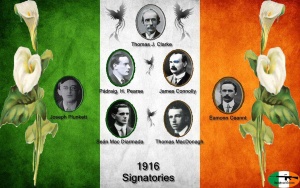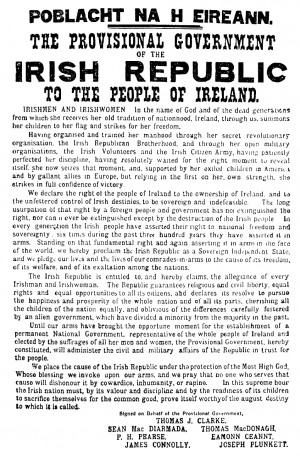1916 Easter rising
 Proclamation signatories | |
| Date | 24 April 1916 - 29 April 1916 |
|---|---|
| Location | Dublin, Ireland |
| Perpetrators | James Connolly, Patrick Pearse, Thomas Clarke, Thomas MacDonagh, Sean McDiarmada, Eamon Ceannt, Joseph Plunkett |
The Easter Rising, also known as the Easter Rebellion, was an armed insurrection in Ireland during Easter Week, April 1916. The Rising was launched by Irish republicans with the aim of ending British rule in Ireland and establishing an independent Irish Republic while the United Kingdom was heavily engaged in World War I. It was the most significant uprising in Ireland since the rebellion of 1798.
Contents
Background
The Acts of Union 1800 united the Kingdom of Great Britain and the Kingdom of Ireland as the United Kingdom of Great Britain and Ireland, abolishing the Irish Parliament and giving Ireland representation in the British Parliament. The Irish Parliament that passed the Act of Union was not representative of the Irish people. Although the vast majority of the Irish population was Catholic, only Protestants could sit in the Irish Parliament and only landowning men could vote.[1] Many MPs were persuaded to vote for the union through bribery.[2] From early on, many Irish nationalists opposed the union as the ensuing exploitation and impoverishment of the island led to a high level of depopulation.[3] Opposition took various forms: constitutional (the Repeal Association; the Home Rule League), social (disestablishment of the Church of Ireland; the Land League) and revolutionary (Rebellion of 1848; Fenian Rising).[4] The Irish Home Rule movement sought to achieve self-government for Ireland, within the United Kingdom. In 1886, the Irish Parliamentary Party (IPP) under Charles Stewart Parnell succeeded in having the First Home Rule Bill introduced in the British parliament, but it was defeated. The Second Home Rule Bill of 1893 was passed by the House of Commons]] but rejected by the House of Lords.
Organisation
Organised by seven members of the Military Council of the Irish Republican Brotherhood,[5] the Rising began on Easter Monday, 24 April 1916, and lasted for six days. Members of the Irish Volunteers — led by schoolmaster and Irish language activist Patrick Pearse, joined by the smaller Irish Citizen Army of James Connolly and 200 women of Cumann na mBan — seized key locations in Dublin and proclaimed an Irish Republic.
The fighting in Dublin
The British Army brought in thousands of reinforcements as well as artillery and a gunboat. There was fierce street fighting on the routes into the city centre, where the rebels put up stiff resistance, slowing the British advance and inflicting heavy casualties. Elsewhere in Dublin, the fighting mainly consisted of sniping and long-range gun battles. The main rebel positions were gradually surrounded and bombarded with artillery. There were isolated actions in other parts of Ireland, with attacks on the Royal Irish Constabulary barracks at Ashbourne, County Meath and in County Galway, and the seizure of the town of Enniscorthy, County Wexford. Due to a last-minute countermand by Volunteer leader Eoin MacNeill, the number of rebels who mobilised was much lower than expected.
Defeat of the uprising
With much greater numbers and heavier weapons, the British Army suppressed the Rising, and Pearse agreed to an unconditional surrender on Saturday 29 April. After the surrender the country remained under martial law. About 3,500 people were taken prisoner by the British, many of whom had played no part in the Rising, and 1,800 of them were sent to internment camps or prisons in Britain. Most of the leaders of the Rising were executed following courts-martial. The Rising brought physical force republicanism back to the forefront of Irish politics, which for nearly 50 years had been dominated by constitutional nationalism. It, and the British reaction to it, led to increased popular support for Irish independence. In December 1918, republicans, represented by the reconstituted Sinn Féin party, won a landslide victory in the general election to the British Parliament. They did not take their seats, but instead convened the First Dáil and declared the independence of the Irish Republic, which led to the War of Independence.
Casualties and property damage
Almost 500 people were killed in the Easter Rising. About 54% were civilians, 30% were British military and police, and 16% were Irish rebels. More than 2,600 were wounded. Many of the civilians were killed as a result of the British using artillery and heavy machine guns, or mistaking civilians for rebels. Others were caught in the crossfire in a crowded city. The shelling and the fires it caused left parts of inner city Dublin in ruins.
Related Documents
| Title | Type | Publication date | Author(s) | Description |
|---|---|---|---|---|
| Document:Easter 1916: When a terrible beauty was born | article | 23 March 2016 | John Wright | The 1916 Easter rising in Dublin against British rule in Ireland written just prior to the centenary of the events, with brief biographiacal information about its two principle leaders. |
| Document:The execution of James Connolly | article | 13 May 2011 | Jim Bliss | A biopic of James Connolly and his 12 May 1916 execution by firing squad whilst strapped to a chair on account of a shattered ankle and chest wounds sustained during the 1916 Easter rising |
References
- ↑ Johnston-Liik, E. M.. MPs in Dublin: Companion to History of the Irish Parliament, 1692-1800. Ulster Historical Foundation, 2006. p.11
- ↑ O'Beirne Ranelagh, John. A Short History of Ireland. Cambridge University Press, 2012. p.102
- ↑ MacDonagh, Oliver, Ireland: The Union and its aftermath, George Allen & Unwin, 1977, ISBN 0-04-941004-0, pp. 14–17
- ↑ Mansergh, Nicholas, The Irish Question 1840–1921, George Allen & Unwin, 1978, ISBN 0-04-901022-0 p. 244
- ↑ Leaders and Men of the Easter Rising: Dublin 1916 Francis X. Martin 1967 p105
Wikipedia is not affiliated with Wikispooks. Original page source here

